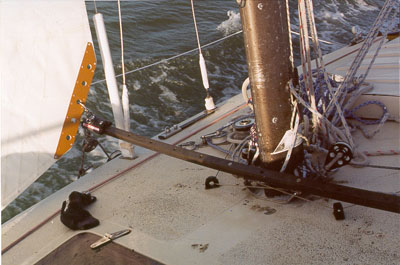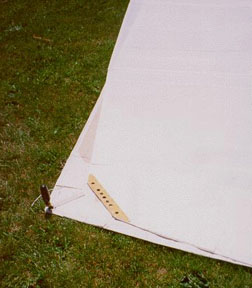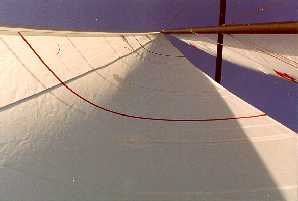The
"Rocky Rail"
Twilight Zone's new self-tacking jib

This system is used on a Merit 25, I=28.75 ft (8.76 m) and J=9.66 ft
(2.94 m). The boat is 24.5 ft (7.47 m) long and weighs 3,120 lb (1,415 kg)
in measurement trim.
The decision to develop a "floating track" for a self-tacking jib was
driven by two considerations:
1) The boat is heavily raced and often sails with 150% or larger
overlapping deck-sweeping jibs. A conventional track would be a serious
obstruction during tacks. But unlike a fixed track, the ends of the
floating track lie flat on the deck when not in use (and the track is
easily unrigged and removed to clean things up even more on light-air
days).
2) The elimination of the sheet block on the car allows the radius of
the track to be larger without violating the "low energy at the ends"
condition necessary for easy self-tacking. Rule of thumb for conventional
(Soling style) self-tacking tracks is to have track radius approximately
equal to the J measurement. For the floating track, radius equal to half
the jib hoist appears more then adequate, and a larger radius (nearly
straight) track would probably work.
Detailed description of the "Rocky Rail" self-tacking jib
system:

The track is a Harken 15, 5 ft. long, bent upwards at 15 ft.
radius (radius
of track = half of jib hoist length). The top of the track is on
the inside of the bend. 262 trim caps (cosmetic only) are on the
track ends.
Harken 215 car. The clew of the jib is shackled directly to the
car.
A small bale is attached to each end of the track by drilling
transversely through the track (this is a fore-and-aft hole in
vessel coordinates, in case there's any confusion) and
through-bolting. The bale is
approx. 3" long. (This length appears to be necessary to help
prevent the curved track from "capsizing" when the car is in the
middle, at the low point of the track.) The bales also serve as
the end stops.
There is a separate conventional jib sheet on each side, with the
lead block on the perforated aluminum toe-rail extrusion. But the
sheets terminate with snap shackles on the bales at the ends of
the track, and never attach directly to the sail.
The standard swivel shackles are removed from the car and bolted
to the bottom of the track as attachment points for the barber
haulers, each 4" from the center of the track.
There are two barber haulers, each runs from the shackle on the
bottom of the track to a fairlead on deck approx. 0.5 ft.
outboard of the centerline on the opposite side.
The first test sail of the "Rocky Rail" self-tacking system
was perfromed on October 17, 1996. Results were very good.
This test was with an old 93% #3 that was built in '87 or '88. LP was
short LP because at that time Twilight Zone's barber hauler
system required the clew to pass in front of the shrouds.
The trial was in wind that never got above the 10 knot range, but the
clew had no trouble sliding to the new side. Sail trim control was
excellent, with twist and sheeting angle controled in the conventional
way: adjusting sheet lead position and barber hauler setting. The only
time the car needed help sliding all the way across to the stop was
when jibing from a light-air broad reach or run.
Trick #1: To coax the car across, pull in the sheet in on the
old side. This rocks the track so the new side is now "up" and the
car "squirts" to the other end of the track.
What remains to be determined is how badly the floating track might flop
around in strong wind, when the sail flogs.
Update: August 1997

The custom sail is noticeably more powerfull than the conventional #3
that it replaces. It has 5 battens and a cut-away clew to keep the sail at
maximum legal size under class rules (sail must fit within boundaries of a
100% LP jib that meets the "proportional girth" limits). The photo shows
the sail placed on top of the old (and slightly shrunk with age) North
Kevlar #3, built with the usual hollow roach. Tack and head position is
idendical for both sails. The extra roach area on the new sail more than
makes up for the lost area around the clew.
The track has proved extremely effective, but the first one failed due
to poor placement of the barber hauler attachment points on the track.
When one sheet had to be released suddenly to recover from a knockdown
following a fast tack (crew really has to scramble across
to keep up with what the boat can do) the track was supported only at the
near-mid-point barber hauler attachement, but was still under load from
the sail at the end. The track broke in half. The current setup now has
barber haulers leading to the car rather than to the track.
The flogging question: Only a problem after the track broke, when the
clew-board flogged itself right off the sail. Attachment details have been
modified for larger clamping forces between the sides of the clew-board.
The sheet is now rigged as a single double-ended control, allowing
asjustment from the high side and preserving the sheet setting from tack
to tack. It runs forward to a pair of blocks on the foredeck and then back
to the other side of the track. It was necessary to add short wire leaders
to limit the maximum downward displacement of the "lazy" side under the
sheet load in order to preserve the easy self-tacking in light wind.

The initial sail design was too deep, with about 16% measured camber
at moderately tight settings. It was powerfull in light air, but not able
to point high and feather effectviely in heavy air. Also note the contact
of the leech against the forward face of the spreader, indicating that
the sail is right at maximum size to fill the foretriangle.
We had a class win in Wheeler Regatta (and 2nd overall in fleet) and two
very good finishes in Stone cup before the failure. Latest mods still to
be tested tested in competition. It's wonderful for daysailing.
The Mark II, rev. 2 modifications:
The next version will have barber haulers going to the clewboard
instead of the car, and lead to the opposite rail in a slightly forward
postion. This will also address the current setup's weak suit: reaching
and running. By casting off the clewboard shackle from the car and using
the barber haulers as sheets, an ideal reaching geometry will be
available.
"Call me Fishmeal" (Fishmeal's home page)



